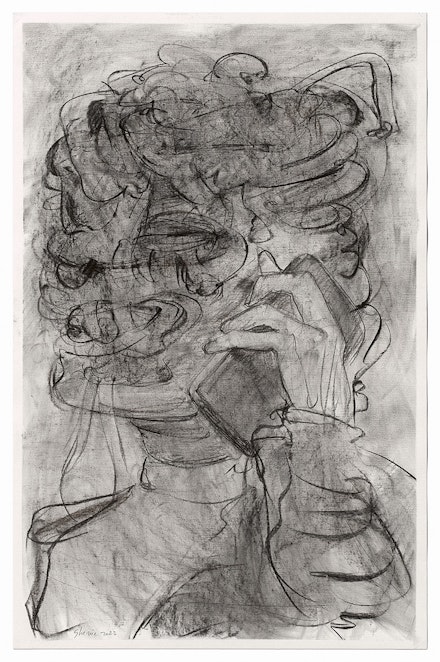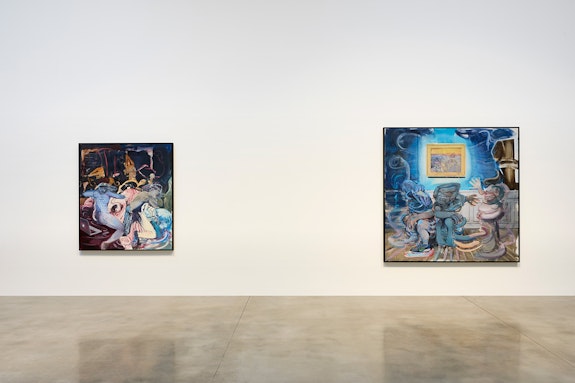ArtSeen
Adrian Ghenie: The Brave New World

On View
Pace GalleryThe Brave New World
November 10–December 22, 2023
Gestural and fluid, bold and frenetic. Today we constantly check our electronics: cell phones, laptops, tablets. We don’t leave home without them; most of us feel a sense of unease in their absence. These devices alienate us, and yet we’re addicted to them. This experience is universal, and it represents a core theme in one renowned European artist’s major solo exhibition.
Pace Gallery presents The Brave New World, featuring eleven new paintings and four works on paper by Romanian artist Adrian Ghenie (b. 1977). At the gallery’s 510 West 25th Street location, viewers will take in Ghenie’s visual interpretation of the relationship between the human body and technology, examining the way our devices and fleeting imagery have transformed our world and the relationships therein. Like Francis Bacon, Ghenie has described the innate, reactive experience he wants his works to elicit, and this “visceral repulsion” is abundant here. Ghenie depicts distorted, corpulent bodies interacting with their devices, staring at buzzing screens, holding phones or watching television. Throughout, the artist sheds light on the fact that these items—devices supposedly created to strengthen our interpersonal relationships—have only increased our collective isolation. Our devices are contradictory in this way, yet we still find solace in them.

In The Spanish Room (2023), two featureless visitors sit in a museum gallery, backs to the paintings on the walls as they hunch over their illuminated phones. They don’t seem to know each other, just as they appear unaware of the Velázquez works hanging behind them. The red and pink museum walls offer implications of red meat or even blood, encircling the subjects; while the motivations of Ghenie’s figures are unclear, they are visibly distracted and painted so frantically that even seated one might assume they’re moving. One might also argue that the room—or the cell phones that serve as focal points within the space—consumes these figures, eating them alive.
Distraction is equally evident in The Hotel Room (2023). Traditionally a place of rest, this space is one of pure chaos: suitcase open on the floor, only partially unpacked; walls covered in indecipherable décor; and an incoherent figure painted with swirling, multihued strokes of red, pink, gray, and beige. The fleshy tones are deeply human, yet the figure focuses entirely on the technology aglow in front of him. From behind, we see the subject gazing at a wall-mounted TV, standing up straight despite the adjacent hotel bed, watching a semi-figurative rendering of former US President Donald Trump with unmatched concentration. Ghenie paints the connection between the subject’s eyes and the television screen, hinting at the emission of light and sound through a series of blue, black, and red-pink curved lines. In this fashion, the artist proves that even in domestic spaces, privacy is limited, Big Brother is always watching, and we no longer understand the value of peace and quiet. At every waking moment, we prioritize the consumption of information—but is this information factual?

The eyes and the hands once served as symbols of connection. In Ghenie’s world, they allow us to navigate our devices with relative ease. In Impossible Body 8 (2023), the hand is no longer an apparatus meant to help us touch or connect, but a tool for consuming data. The painting shows a lone subject standing in profile; the viewer takes in the pink swell of the brain, the harried red mouth, and the complex skeleton that exists below the man’s T-shirt, allowing the ribs and spine to settle. As we interact with this figure, we seemingly have x-ray vision, observing every aspect of this person’s near-abstract body, but the interaction is one-sided. The subject does not acknowledge his audience, nor does he engage with his direct environment. He places one hand to his chest; the other hand holds a bright blue cell phone, situating it right by his ear. Here is the brave new world of the exhibition’s title, named for the dystopian views of Aldous Huxley’s 1932 novel.
Fraught and fragmented, Ghenie embraces discomfort in every work, perhaps drawing inspiration from his own lived experience in Communist Romania, under the dictatorship of Nicolae Ceauşescu through the end of the leader’s regime in 1989. As we move further into the twenty-first century, though, Ghenie’s paintings serve as snapshots of life under the power of another entity: the devices that surveil us.

